List of Western films of the 1990s and Fractal: Difference between pages
No edit summary |
→Applications: added a point |
||
| Line 1: | Line 1: | ||
[[Image:Mandel zoom 00 mandelbrot set.jpg|300px|right|thumb|The [[Mandelbrot set]] is a famous example of a '''fractal'''.]] |
|||
{{Westernfilmlist}} |
|||
[[Image:Mandelpart2_red.png|right|300px|thumb|A closer view of the Mandelbrot set.]] |
|||
{{Expand list|date=August 2008}} |
|||
A list of '''[[Western film]]'''s released in the [[1990s]]. |
|||
A '''fractal''' is generally "a rough or fragmented [[Shape|geometric shape]] that can be split into parts, each of which is (at least approximately) a reduced-size copy of the whole,"<ref>{{cite book |
|||
{| class="wikitable" |
|||
| last = Mandelbrot |
|||
|- |
|||
| first = B.B. |
|||
! Title !! Director !! Cast !! Country !! Sub-Genre/Notes |
|||
| title = The Fractal Geometry of Nature |
|||
|- |
|||
| publisher = W.H. Freeman and Company. |
|||
| {{Yearheader}} | '''[[1990 in film|1990]]''' |
|||
| date = 1982 |
|||
|- |
|||
| id = ISBN 0-7167-1186-9}}</ref> a property called [[self-similarity]]. The term was coined by [[Benoît Mandelbrot]] in 1975 and was derived from the [[Latin]] ''[[wikt:fractus|fractus]]'' meaning "broken" or "fractured." |
|||
|'''''[[Back to the Future Part III]]''''' || [[Robert Zemeckis]] || [[Michael J. Fox]], [[Christopher Lloyd]], [[Mary Steenburgen]], [[Thomas F. Wilson]] || {{flagicon|USA}} || science fiction/comedy Western |
|||
|- |
|||
|'''''[[Border Shootout]]''''' || [[Chris McIntyre]] || [[Michael Forest]], [[Cody Glenn]], [[Michael Horse]] || {{flagicon|USA}} || traditional Western |
|||
|- |
|||
|'''''[[Dances with Wolves]]''''' || [[Kevin Costner]] || [[Kevin Costner]], [[Mary McDonnell]], [[Graham Greene (actor)|Graham Greene]] || {{flagicon|USA}} || epic Western |
|||
|- |
|||
|'''''[[Grim Prairie Tales]]''''' || [[Wayne Coe]] || [[James Earl Jones]], [[Brad Dourif]] || {{flagicon|USA}} || [[Weird West|horror Western]] |
|||
|- |
|||
|'''''[[Quigley Down Under]]'''''||[[Simon Wincer]]||[[Tom Selleck]], [[Laura San Giacomo]], [[Alan Rickman]]||{{flagicon|Australia}} || |
|||
|- |
|||
|'''''[[Young Guns II]]''''' || [[Geoff Murphy]] || [[Emilio Estevez]], [[Kiefer Sutherland]], [[Lou Diamond Phillips]], [[Christian Slater]] || {{flagicon|USA}} || outlaw Western |
|||
|- |
|||
|'''''[[El Diablo]]''''' || [[Peter Markle]] || [[Anthony Edwards]], [[Louis Gossett Jr.]] || {{flagicon|USA}} || comedy Western |
|||
A fractal often has the following features:<ref>{{cite book |
|||
|- |
|||
| last = Falconer |
|||
| {{Yearheader}} | '''[[1991 in film|1991]]''' |
|||
| first = Kenneth |
|||
|- |
|||
| title = Fractal Geometry: Mathematical Foundations and Applications |
|||
|'''''[[An American Tail: Fievel Goes West]]''''' || [[Phil Nibbelink]], [[Simon Wells]] || [[James Stewart (actor)|James Stewart]] (voice), [[Phillip Glasser]] (voice) || {{flagicon|USA}} || animated Western |
|||
| publisher = John Wiley & Sons, Ltd. |
|||
|- |
|||
| date = 2003 |
|||
|'''''[[City Slickers]]''''' || [[Ron Underwood]] || [[Billy Crystal]], [[Daniel Stern (actor)|Daniel Stern]], [[Helen Slater]], [[Bruno Kirby]], [[Jack Palance]] || {{flagicon|USA}} || contemporary comedy Western |
|||
| pages = xxv |
|||
|- |
|||
| id = ISBN 0-470-84862-6}}</ref> |
|||
|'''''[[Conagher]]''''' || [[Reynaldo Villalobos]] || [[Sam Elliott]], [[Katharine Ross]] || {{flagicon|USA}} || traditional Western |
|||
* It has a fine structure at arbitrarily small scales. |
|||
|- |
|||
* It is too irregular to be easily described in traditional [[Euclidean geometry|Euclidean geometric]] language. |
|||
|'''''[[Into the Badlands]]''''' || [[Sam Pillsbury]] || [[Bruce Dern]], [[Mariel Hemingway]], [[Helen Hunt]], [[Dylan McDermott]] || {{flagicon|USA}} || [[Weird West|horror Western]] |
|||
* It is [[self-similarity|self-similar]] (at least approximately or [[stochastic]]ally). |
|||
|- |
|||
* It has a [[Hausdorff dimension]] which is greater than its [[Lebesgue covering dimension|topological dimension]] (although this requirement is not met by [[space-filling curve]]s such as the [[Hilbert curve]]). |
|||
|'''''[[My Heroes Have Always Been Cowboys]]''''' || [[Stuart Rosenberg]] || [[Scott Glenn]], [[Kate Capshaw]], [[Ben Johnson (actor)|Ben Johnson]], [[Gary Busey]] || {{flagicon|USA}} || contemporary Western |
|||
* It has a simple and [[recursive definition]]. |
|||
|- |
|||
|'''''[[Sundown: The Vampire in Retreat]]''''' || [[Anthony Hickox]] || [[David Carradine]], [[Bruce Campbell]] || {{flagicon|USA}} || [[Weird West|horror Western]] |
|||
|- |
|||
|'''''[[A Thousand Pieces of Gold]]''''' || [[Nancy Kelly]] || [[Rosalind Chao]], [[Chris Cooper (actor)|Chris Cooper]] || {{flagicon|USA}} || [[Revisionist Western]] |
|||
|- |
|||
| {{Yearheader}} | '''[[1992 in film|1992]]''' |
|||
|- |
|||
|'''''[[Mad at the Moon]]''''' || [[Martin Donovan]] || [[Hart Bochner]] || {{flagicon|USA}} || [[Weird West|horror Western]] |
|||
|- |
|||
|'''''[[Thunderheart]]||[[Michael Apted]]||[[Graham Greene (actor)|Graham Greene]], [[Val Kilmer]], [[Sam Shepard]]||{{flagicon|USA}}|| contemporary Western |
|||
|- |
|||
|'''''[[Unforgiven]]'''''||[[Clint Eastwood]]||[[Clint Eastwood]], [[Gene Hackman]], [[Morgan Freeman]], [[Richard Harris]]|| {{flagicon|USA}} || [[Revisionist Western]] |
|||
|- |
|||
| {{Yearheader}} | '''[[1993 in film|1993]]''' |
|||
|- |
|||
|'''''[[Geronimo: An American Legend]]''''' || [[Walter Hill (director)|Walter Hill]] || [[Wes Studi]], [[Gene Hackman]], [[Jason Patric]], [[Robert Duvall]] || {{flagicon|USA}} || [[Revisionist Western]] |
|||
|- |
|||
|'''''[[Posse (1993 film)|Posse]]''''' || [[Mario Van Peebles]] || [[Mario Van Peebles]], [[Woody Strode]] || {{flagicon|USA}} || [[Revisionist Western]] |
|||
|- |
|||
|'''''[[Tombstone (film)|Tombstone]]'''''||[[George P. Cosmatos]]||[[Kurt Russell]], [[Val Kilmer]], [[Bill Paxton]]|| {{flagicon|USA}} || outlaw Western |
|||
|- |
|||
|'''''[[The Ballad of Little Jo]]'''''||[[Maggie Greenwald]]||[[Suzy Amis]], [[Ian McKellen]] || {{flagicon|USA}} || [[Revisionist Western]] |
|||
|- |
|||
|'''''[[Río Diablo]]'''''||[[Rod Hardy]]||[[Kenny Rogers]], [[Travis Tritt]] || {{flagicon|USA}} || |
|||
|- |
|||
|'''''[[Somersby]]'''''||[[Jon Amiel]]||[[Richard Gere]], [[Jodie Foster]], [[Bill Pullman]] || {{flagicon|USA}} || North&South |
|||
|- |
|||
| {{Yearheader}} | '''[[1994 in film|1994]]''' |
|||
|- |
|||
|'''''[[Bad Girls (film)|Bad Girls]]'''''||[[Jonathan Kaplan]]||[[Madeleine Stowe]], [[Mary Stuart Masterson]], [[Andie MacDowell]], [[Drew Barrymore]]|| {{flagicon|USA}} || |
|||
|- |
|||
|'''''[[City Slickers II: The Legend of Curly's Gold]]''''' || [[Paul Weiland]] || [[Billy Crystal]], [[Daniel Stern]], [[Jack Palance]] || {{flagicon|USA}} || contemporary comedy Western |
|||
|- |
|||
|'''''[[Four Eyes and Six Guns]]''''' || [[Piers Haggard]] || [[Judge Reinhold]], [[Patricia Clarkson]] || {{flagicon|USA}} || comedy Western |
|||
|- |
|||
|'''''[[Frank & Jesse]]''''' || [[Robert Boris]] || [[Rob Lowe]], [[Bill Paxton]] || {{flagicon|USA}} || outlaw Western |
|||
|- |
|||
|'''''[[The Last Outlaw (TV)|The Last Outlaw]]''''' || [[Geoff Murphy]] || [[Mickey Rourke]], [[Dermot Mulroney]] || {{flagicon|USA}} || outlaw Western |
|||
|- |
|||
|'''''[[Lightning Jack]]''''' || [[Simon Wincer]] || [[Paul Hogan]], [[Cuba Gooding Jr.]], [[Beverly D'Angelo]] || {{flagicon|USA}}, {{flagicon|Australia}} || comedy Western |
|||
|- |
|||
|'''''[[Maverick (film)|Maverick]]'''''||[[Richard Donner]]||[[Mel Gibson]],[[Jodie Foster]], [[James Garner]]|| {{flagicon|USA}} || comedy Western |
|||
|- |
|||
|'''''[[Oblivion (film)|Oblivion]]''''' || [[Sam Irvin]] || [[Richard Joseph Paul]] || {{flagicon|USA}} || science fiction Western |
|||
|- |
|||
|'''''[[Siringo]]''''' || [[Kevin G. Cremin]] || [[Brad Johnson (actor)|Brad Johnson]], [[Chad Lowe]] || {{flagicon|USA}} || biographical Western |
|||
|- |
|||
|'''''[[Wagons East!]]''''' || [[Peter Markle]] || [[John Candy]], [[Richard Lewis (comedian)|Richard Lewis]] || {{flagicon|USA}} || comedy Western |
|||
|- |
|||
|'''''[[Wyatt Earp (film)|Wyatt Earp]]'''''||[[Lawrence Kasdan]]|| [[Kevin Costner]], [[Dennis Quaid]], [[Gene Hackman]], [[David Andrews (actor)|David Andrews]], [[Linden Ashby]], [[Jeff Fahey]], [[Joanna Going]], [[Linden Ashby]] || {{flagicon|USA}} || traditional Western |
|||
|- |
|||
| {{Yearheader}} | '''[[1995 in film|1995]]''' |
|||
|- |
|||
|'''''[[Black Fox (film)|Black Fox]]''''' || [[Steven Hilliard Stern]] || [[Christopher Reeve]], [[Tony Todd]] || {{flagicon|USA}}, {{flagicon|Canada}} || traditional Western |
|||
|- |
|||
|'''''[[Buffalo Girls#Film adaptation|Buffalo Girls]]''''' || [[Rod Hardy]] || [[Angelica Huston]], [[Melanie Griffith]], [[Gabriel Byrne]], [[Peter Coyote]] || {{flagicon|USA}} || [[Revisionist Western]] |
|||
|- |
|||
|'''''[[In Pursuit of Honor]]''''' || [[Ken Olin]] || [[Don Johnson]], [[Craig Sheffer]], || {{flagicon|USA}} || [[Contemporany Western]] |
|||
|- |
|||
|'''''[[Dead Man]]'''''||[[Jim Jarmusch]]||[[Johnny Depp]]||{{flagicon|USA}} || [[Acid Western]] |
|||
|- |
|||
|'''''[[The Desperate Trail]]''''' || [[P.J. Pesce]] || [[Sam Elliott]], [[Craig Sheffer]] || {{flagicon|USA}} || traditional Western |
|||
|- |
|||
|'''''[[A Fistful of Fingers]]''''' || [[Edgar Wright]] || [[Graham Low (actor)|Graham Low]] || {{flagicon|UK}} || comedy Western |
|||
|- |
|||
|'''''[[Gunfighter's Moon]]''''' || [[Larry Ferguson]] || [[Lance Henriksen]], [[Kay Lenz]] || {{flagicon|USA}} || romance Western |
|||
|- |
|||
|'''''[[Last of the Dogmen]]''''' || [[Tab Murphy]] || [[Tom Berenger]], [[Barbara Hershey]] || {{flagicon|USA}} || contemporary/romance Western |
|||
|- |
|||
|'''''[[The Quick and the Dead (1995 film)|The Quick and the Dead]]''''' || [[Sam Raimi]] || [[Sharon Stone]], [[Gene Hackman]], [[Russell Crowe]], [[Leonardo DiCaprio]] || {{flagicon|USA}} || |
|||
|- |
|||
|'''''[[Wild Bill (film)|Wild Bill]]''''' || [[Walter Hill (director)|Walter Hill]] || [[Jeff Bridges]], [[Ellen Barkin]], [[John Hurt]], [[David Arquette]] || {{flagicon|USA}} || [[Revisionist Western]] |
|||
|- |
|||
| {{Yearheader}} | '''[[1996 in film|1996]]''' |
|||
|- |
|||
|'''''[[The Cherokee Kid]]''''' || [[Paris Barclay]] || [[Sinbad (actor)|Sinbad]], [[James Coburn]] || {{flagicon|USA}} || comedy Western |
|||
|- |
|||
|'''''[[Lone Star (1996 film)|Lone Star]]''''' || [[John Sayles]] || [[Chris Cooper (actor)|Chris Cooper]], [[Elizabeth Peña]], [[Kris Kristofferson]], [[Matthew McConaughey]] || {{flagicon|USA}} || contemporary Western |
|||
|- |
|||
|'''''[[Riders of the Purple Sage#Movie Versions|Riders of the Purple Sage]]''''' || [[Charles Haid]] || [[Ed Harris]], [[Amy Madigan]] || {{flagicon|USA}} || traditional Western |
|||
|- |
|||
| {{Yearheader}} | '''[[1997 in film|1997]]''' |
|||
|- |
|||
|'''''[[Last Stand at Sabre River]]''''' || [[Dick Lowry]] || [[Tom Selleck]], [[Suzy Amis]] || {{flagicon|USA}} || traditional Western |
|||
|- |
|||
|'''''[[The Postman (film)|The Postman]]''''' || [[Kevin Costner]] ||[[Kevin Costner]], [[Will Patton]] || {{flagicon|USA}} || apocolyptic/science fiction Western |
|||
|- |
|||
| {{Yearheader}} | '''[[1998 in film|1998]]''' |
|||
|- |
|||
|'''''[[Almost Heroes]]''''' || [[Christopher Guest]] || [[Chris Farley]], [[Matthew Perry (actor)|Matthew Perry]] || {{flagicon|USA}} || comedy Western |
|||
|- |
|||
|'''''[[Gunfighter (film)|Gunfighter]]''''' || [[Christopher Coppola]] || [[Robert Carradine]], [[Martin Sheen]] || {{flagicon|USA}} || B Western |
|||
|- |
|||
|'''''[[Gunslinger's Revenge]]''''', (aka, ''Il Mio West'') || [[Giovanni Veronesi]] || [[Leonardo Pieraccioni]], [[Harvey Keitel]] || {{flagicon|Italy}} || [[Spaghetti Western]] |
|||
|- |
|||
|'''''[[The Hi-Lo Country]]''''' || [[Stephen Frears]] || [[Sam Elliott]], [[Billy Crudup]] || {{flagicon|USA}} || |
|||
|- |
|||
|'''''[[Vampires (film)|Vampires]]''''' || [[John Carpenter]] || [[James Woods]], [[Daniel Baldwin]], [[Sheryl Lee]] || {{flagicon|USA}} || [[Weird West|horror Western]] |
|||
|- |
|||
|'''''[[Wind River (film)|Wind River]]''''' || [[Tom Shell]] || [[Blake Heron]], [[A. Martinez]], [[Karen Allen]], [[Russell Means]], [[Wes Studi]] || {{flagicon|USA}} || [[Revisionist Western]] |
|||
|- |
|||
| {{Yearheader}} | '''[[1999 in film|1999]]''' |
|||
|- |
|||
|'''''[[The Jack Bull]]''''' || [[John Badham]] || [[John Cusack]], [[John Goodman]], [[L.Q. Jones]] || {{flagicon|USA}} || traditional Western |
|||
|- |
|||
|'''''[[Outlaw Justice]]''''' || [[Bill Corcoran]] || [[Willie Nelson]], [[Kris Kristofferson]] || {{flagicon|USA}} || outlaw Western |
|||
|- |
|||
|'''''[[Purgatory (film)|Purgatory]]''''' || [[Uli Edel]] || [[Sam Shepard]], [[Eric Roberts]], [[Donnie Wahlberg]], [[Randy Quaid]], [[Brad Rowe (actor)|Brad Rowe]] || {{flagicon|USA}} || fantasy/[[Weird West|horror Western]] |
|||
|- |
|||
|'''''[[Ravenous]]''''' || [[Antonia Bird]] || [[Robert Carlyle]], [[Jeffrey Jones]], [[Guy Pearce]] || {{flagicon|USA}} || [[Weird West|horror Western]] |
|||
|- |
|||
|'''''[[Ride with the Devil (film)|Ride with the Devil]]''''' || [[Ang Lee]] || [[Tobey Maguire]], [[Skeet Ulrich]], [[Jeffrey Wright]], [[Simon Baker]] || {{flagicon|USA}} || [[Revisionist Western]] |
|||
|- |
|||
|'''''[[You Know My Name (film)|You Know My Name]]''''' || [[John Kent Harrison]] || [[Sam Elliott]], [[James Gammon]] || {{flagicon|USA}} || |
|||
|- |
|||
|'''''[[Wild Wild West]]''''' || [[Barry Sonnenfeld]] || [[Will Smith]], [[Kevin Kline]] || {{flagicon|USA}} || fantasy/science fiction Western |
|||
|- |
|||
|} |
|||
Because they appear similar at all levels of magnification, fractals are often considered to be infinitely complex (in informal terms). Natural objects that approximate fractals to a degree include clouds, mountain ranges, lightning bolts, coastlines, and snow flakes. However, not all self-similar objects are fractals—for example, the [[real line]] (a straight [[Line_(geometry)|Euclidean]] line) is formally self-similar but fails to have other fractal characteristics. |
|||
===TV series=== |
|||
* ''[[The Adventures of Brisco County Jr.]]'' |
|||
Images of fractals can be created using [[fractal generating software]]. |
|||
===TV series=== |
|||
* ''[[Adventures of the Old West]]'' |
|||
== |
==History== |
||
[[image:animated construction of Sierpinski Triangle.gif|left|thumb|200px|Animated construction of a [[Sierpiński Triangle]], only going nine generations of [[infinity|infinite]]—click for larger image.]] |
|||
* ''[[Les Amants de riviere rouge]]'' |
|||
[[Image:Von Koch curve.gif|right|thumbnail|250px|To create a [[Koch snowflake]], one begins with an equilateral triangle and then replaces the middle third of every line segment with a pair of line segments that form an equilateral "bump." One then performs the same replacement on every line segment of the resulting shape, ad infinitum. With every [[iteration]], the perimeter of this shape increases by one third of the previous length. The Koch snowflake is the result of an infinite number of these iterations, and has an infinite length, while its area remains [[Wiktionary:finite|finite]]. For this reason, the Koch snowflake and similar constructions were sometimes called "monster curves." <!-- This is NOT merely a matter of "approaching infinity but never reaching it". The actual length of the boundary of the union is infinite. [[User:Michael Hardy]] -->]] |
|||
{{Filmsbygenre}} |
|||
The [[mathematics]] behind fractals began to take shape in the 17th century when mathematician and philosopher [[Gottfried Leibniz|Leibniz]] considered [[recursion|recursive]] self-similarity (although he made the mistake of thinking that only the straight line was self-similar in this sense). |
|||
[[Category:Lists of films by genre]] |
|||
[[Category:Western films|*]] |
|||
It took until 1872 before a function appeared whose [[Graph of a function|graph]] would today be considered fractal, when [[Karl Weierstrass]] gave an [[Weierstrass function|example]] of a function with the non-[[intuition (knowledge)|intuitive]] property of being everywhere [[continuous function|continuous]] but [[nowhere differentiable]]. In 1904, [[Helge von Koch]], dissatisfied with Weierstrass's very abstract and analytic definition, gave a more geometric definition of a similar function, which is now called the [[Koch snowflake]]. In 1915, [[Waclaw Sierpinski]] constructed his [[Sierpinski triangle|triangle]] and, one year later, his [[Sierpinski carpet|carpet]]. Originally these geometric fractals were described as curves rather than the 2D shapes that they are known as in their modern constructions. The idea of self-similar curves was taken further by [[Paul Pierre Lévy]], who, in his 1938 paper ''Plane or Space Curves and Surfaces Consisting of Parts Similar to the Whole'' described a new fractal curve, the [[Lévy C curve]]. |
|||
[[Category:1990s in film]] |
|||
[[Georg Cantor]] also gave examples of [[subset]]s of the real line with unusual properties—these [[Cantor set]]s are also now recognized as fractals. |
|||
Iterated functions in the [[complex plane]] were investigated in the late 19th and early 20th centuries by [[Henri Poincaré]], [[Felix Klein]], [[Pierre Fatou]] and [[Gaston Julia]]. However, without the aid of modern computer graphics, they lacked the means to visualize the beauty of many of the objects that they had discovered. |
|||
In the 1960s, [[Benoît Mandelbrot]] started investigating self-similarity in papers such as ''[[How Long Is the Coast of Britain? Statistical Self-Similarity and Fractional Dimension]]'', which built on earlier work by [[Lewis Fry Richardson]]. Finally, in 1975 Mandelbrot coined the word "fractal" to denote an object whose [[Hausdorff dimension|Hausdorff-Besicovitch dimension]] is greater than its [[topological dimension]]. He illustrated this mathematical definition with striking computer-constructed visualizations. These images captured the popular imagination; many of them were based on recursion, leading to the popular meaning of the term "fractal". |
|||
==Examples== |
|||
[[Image:Julia set (indigo).png|thumb|A [[Julia set]], a fractal related to the Mandelbrot set]] |
|||
A relatively simple class of examples is given by the [[Cantor set]]s, [[Sierpinski triangle]] and [[Sierpinski carpet|carpet]], [[Menger sponge]], [[dragon curve]], [[space-filling curve]], and [[Koch snowflake|Koch curve]]. Additional examples of fractals include the [[Lyapunov fractal]] and the limit sets of [[Kleinian group]]s. Fractals can be [[deterministic]] (all the above) or [[stochastic]] (that is, non-deterministic). For example, the trajectories of the [[Brownian motion]] in the plane have a Hausdorff dimension of 2. |
|||
[[Chaos theory|Chaotic dynamical systems]] are sometimes associated with fractals. Objects in the [[phase space]] of a [[dynamical system]] can be fractals (see [[attractor]]). Objects in the [[parameter space]] for a family of systems may be fractal as well. An interesting example is the [[Mandelbrot set]]. This set contains whole discs, so it has a Hausdorff dimension equal to its topological dimension of 2—but what is truly surprising is that the [[Boundary (topology)|boundary]] of the Mandelbrot set also has a Hausdorff dimension of 2 (while the topological dimension of 1), a result proved by [[Mitsuhiro Shishikura]] in 1991. A closely related fractal is the [[Julia set]]. |
|||
Even simple smooth curves can exhibit the fractal property of self-similarity. For example the [[power-law]] curve (also known as a [[Pareto distribution]]) produces similar shapes at various magnifications. |
|||
==Generating fractals == |
|||
<table style="float:right;width:130px;padding-left:20px"> |
|||
<tr><td>[[Image:Mandelbrot-similar-x1.jpg|The whole Mandelbrot set]] |
|||
<tr><td>[[Image:Mandelbrot-similar-x6.jpg|Mandelbrot zoomed 6x]] |
|||
<tr><td>[[Image:Mandelbrot-similar-x100.jpg|Mandelbrot Zoomed 100x]] |
|||
<tr><td>[[Image:Mandelbrot-similar-x2000.jpg|Mandelbrot Zoomed 2000x]] <small>Even 2000 times magnification of the Mandelbrot set uncovers fine detail resembling the full set.</small></table> |
|||
Four common techniques for generating fractals are: |
|||
:* '''Escape-time fractals''' — (also known as "orbits" fractals) These are defined by a [[recurrence relation]] at each point in a space (such as the [[complex plane]]). Examples of this type are the [[Mandelbrot set]], [[Julia set]], the [[Burning Ship fractal]], the [[Nova fractal]] and the [[Lyapunov fractal]]. The 2d vector fields that are generated by one or two iterations of escape-time formulae also give rise to a fractal form when points (or pixel data) are passed through this field repeatedly. |
|||
:* '''[[Iterated function system]]s''' — These have a fixed geometric replacement rule. [[Cantor set]], [[Sierpinski carpet]], [[Sierpinski gasket]], [[Peano curve]], [[Koch snowflake]], [[dragon curve|Harter-Heighway dragon curve]], [[T-Square (fractal)|T-Square]], [[Menger sponge]], are some examples of such fractals. |
|||
:* '''Random fractals''' — Generated by stochastic rather than deterministic processes, for example, trajectories of the [[Brownian motion]], [[Lévy flight]], [[fractal landscapes]] and the [[Brownian tree]]. The latter yields so-called mass- or dendritic fractals, for example, [[diffusion-limited aggregation]] or [[reaction-limited aggregation]] clusters. |
|||
:* '''Strange attractors''' — Generated by iteration of a map or the solution of a system of initial-value differential equations that exhibit chaos. |
|||
==Classification == |
|||
Fractals can also be classified according to their self-similarity. There are three types of self-similarity found in fractals: |
|||
:*'''Exact self-similarity''' — This is the strongest type of self-similarity; the fractal appears identical at different scales. Fractals defined by [[iterated function]] systems often display exact self-similarity. |
|||
:*'''Quasi-self-similarity''' — This is a loose form of self-similarity; the fractal appears approximately (but not exactly) identical at different scales. Quasi-self-similar fractals contain small copies of the entire fractal in distorted and degenerate forms. Fractals defined by [[recurrence relation]]s are usually quasi-self-similar but not exactly self-similar. |
|||
:*'''Statistical self-similarity''' — This is the weakest type of self-similarity; the fractal has numerical or statistical measures which are preserved across scales. Most reasonable definitions of "fractal" trivially imply some form of statistical self-similarity. ([[Fractal dimension]] itself is a numerical measure which is preserved across scales.) Random fractals are examples of fractals which are statistically self-similar, but neither exactly nor quasi-self-similar. |
|||
{{clear}} |
|||
==In nature== |
|||
Approximate fractals are easily found in nature. These objects display self-similar structure over an extended, but finite, scale range. Examples include clouds, [[snow|snow flakes]], [[crystal]]s, [[mountain|mountain range]]s, [[lightning]], [[river|river networks]], [[cauliflower]] or [[broccoli]], and systems of [[blood vessel]]s and [[pulmonary vessels]]. [[How Long Is the Coast of Britain? Statistical Self-Similarity and Fractional Dimension|Coastlines]] may be loosely considered fractal in nature. |
|||
Trees and ferns are fractal in nature and can be modeled on a computer by using a [[recursion|recursive]] [[algorithm]]. This recursive nature is obvious in these examples — a branch from a tree or a [[frond]] from a fern is a miniature replica of the whole: not identical, but similar in nature. |
|||
In 1999, certain self similar fractal shapes were shown to have a property of "frequency invariance" — the same electromagnetic properties no matter what the frequency — from [[Maxwell's equations]] (see [[fractal antenna]]).<ref>Hohlfeld,R., and Cohen, N.,"SELF-SIMILARITY AND THE GEOMETRIC REQUIREMENTS FOR FREQUENCY INDEPENDENCE IN ANTENNAE ", Fractals, Vol. 7, No. 1 (1999) 79-84</ref> |
|||
<gallery caption= widths="200px" heights="200px"> |
|||
Image:Animated fractal mountain.gif|A fractal that models the surface of a mountain (animation) |
|||
Image:Bransleys fern.png|A fractal fern computed using an [[Iterated function system]] |
|||
Image:Cauliflower Fractal AVM.JPG|Cauliflower fractal |
|||
Image:PentagramFractal.PNG|Fractal [[pentagram]] drawn with a [[vector]] [[iteration]] program |
|||
</gallery> |
|||
==In creative works== |
|||
Fractal patterns have been found in the paintings of American artist [[Jackson Pollock]]. While Pollock's paintings appear to be composed of chaotic dripping and splattering, computer analysis has found fractal patterns in his work.<ref>[http://www.phys.unsw.edu.au/PHYSICS_!/FRACTAL_EXPRESSIONISM/fractal_taylor.html Richard Taylor, Adam P. Micolich and David Jonas. ''Fractal Expressionism : Can Science Be Used To Further Our Understanding Of Art?'']</ref> |
|||
[[Decalcomania]], a technique used by artists such as [[Max Ernst]], can produce fractal-like patterns.<ref>[http://classes.yale.edu/Fractals/Panorama/ A Panorama of Fractals and Their Uses] by Michael Frame and Benoît B. Mandelbrot</ref> It involves pressing paint between two surfaces and pulling them apart. |
|||
Fractals are also prevalent in [[African art]] and architecture. Circular houses appear in circles of circles, rectangular houses in rectangles of rectangles, and so on. Such scaling patterns can also be found in African textiles, sculpture, and even cornrow hairstyles.<ref>[http://www.rpi.edu/~eglash/eglash.dir/afractal/afractal.htm Ron Eglash. ''African Fractals: Modern Computing and Indigenous Design. New Brunswick: Rutgers University Press 1999.'']</ref> |
|||
<gallery caption= widths="200px" heights="200px"> |
|||
Image:Glue1_800x600.jpg|A fractal is formed when pulling apart two glue-covered [[acryl]]ic sheets. |
|||
Image:Square1.jpg|High voltage breakdown within a 4″ block of acrylic creates a fractal [[Lichtenberg figure]]. |
|||
Image:Microwaved-DVD.jpg|Fractal branching occurs in a fractured surface such as a microwave-irradiated [[DVD]]<ref name='J. Phys. A 21 July 1990'> {{cite journal|title=The fractal nature of a fracture surface|journal=[[Journal of Physics A]]|date=21 July 1990|first=Gongwen|last=Peng|coauthors=Decheng Tian|volume=23|issue=14|pages=3257–3261|doi=10.1088/0305-4470/23/14/022|url=http://www.iop.org/EJ/abstract/0305-4470/23/14/022|format=|accessdate=2007-06-02}}</ref> |
|||
Image:Fractal_Broccoli.jpg|[[Romanesco broccoli]] showing very fine natural fractals |
|||
Image:DLA_Cluster.JPG|A [[Diffusion-limited aggregation|DLA cluster]] grown from a [[copper(II) sulfate]] solution in an [[electrodeposition]] cell |
|||
Image:Woodburn_fractal.jpg|A "woodburn" fractal |
|||
Image:Phoenix(Julia).gif|A magnification of the phoenix set |
|||
Image:Complex fractle image.PNG|Pascal generated fractal |
|||
Image:Lines Apophysis Fractal Flame.jpg | A [[fractal flame]] created with the program [[Apophysis (software)|Apophysis]] |
|||
</gallery> |
|||
==Applications== |
|||
{{main|Fractal analysis}} |
|||
As described above, random fractals can be used to describe many highly irregular real-world objects. Other applications of fractals include:<ref>{{cite web|url=http://library.thinkquest.org/26242/full/ap/ap.html|title=Applications|accessdate=2007-10-21}}</ref> |
|||
* [[Categorisation|Classification]] of [[histopathology]] slides in [[medicine]] |
|||
* [[Fractal landscape]] or [[Coast]]line complexity |
|||
* Enzyme/enzymology ([[Michaelis-Menten kinetics]]) |
|||
* Generation of new music |
|||
* Generation of various [[art]] forms |
|||
* [[Signal (information theory)|Signal]] and [[Fractal compression|image compression]] |
|||
* Creation of digital photographic enlargements |
|||
* [[Seismology]] |
|||
* [[Fractal in soil mechanics]] |
|||
* [[game design|Computer and video game design]], especially [[computer graphics]] for [[life|organic]] environments and as part of [[procedural generation]] |
|||
* Fractography and [[fracture mechanics]] |
|||
* [[Fractal antenna]]s — Small size antennas using fractal shapes |
|||
* [[SAXS|Small angle scattering theory of fractally rough systems]] |
|||
* Neo-[[hippie]]s' [[t-shirt]]s and other [[fashion]] |
|||
* Generation of patterns for camouflage, such as [[MARPAT]] |
|||
* [[Digital sundial]] |
|||
* [[Technical analysis]] of price series (see [[Elliott wave principle]]) |
|||
==See also== |
|||
{{multicol}} |
|||
* [[Bifurcation theory]] |
|||
* [[Butterfly effect]] |
|||
* [[Chaos theory]] |
|||
* [[Complexity]] |
|||
* [[Constructal theory]] |
|||
* [[Contraction mapping theorem| Contraction mapping theorem]] |
|||
* [[Diamond-square algorithm]] |
|||
* [[Droste effect]] |
|||
* [[Feigenbaum function]] |
|||
{{multicol-break}} |
|||
* [[Fractal art]] |
|||
* [[Fractal compression]] |
|||
* [[Fractal cosmology]] |
|||
* [[Fractal flame]] |
|||
* [[Fractal landscape]] |
|||
* [[Fractint]] |
|||
* [[Fracton]] |
|||
* [[Graftal]] |
|||
* [[Greeble]] |
|||
* [[Lacunarity]] |
|||
{{multicol-break}} |
|||
* [[List of fractals by Hausdorff dimension]] |
|||
* [[List of publications in mathematics#Fractal geometry|Publications in fractal geometry]] |
|||
* [[Newton fractal]] |
|||
* [[Recursion]] |
|||
* [[Recursionism]] |
|||
* [[Sacred geometry]] |
|||
* [[Self-reference]] |
|||
* [[Strange loop]] |
|||
* [[Turbulence]] |
|||
{{multicol-end}} |
|||
==References== |
|||
{{reflist}} |
|||
==Further reading== |
|||
* Barnsley, Michael F., and Hawley Rising. ''Fractals Everywhere''. Boston: Academic Press Professional, 1993. ISBN 0-12-079061-0 |
|||
* Falconer, Kenneth. '' Techniques in Fractal Geometry''. John Willey and Sons, 1997. ISBN 0-471-92287-0 |
|||
* Jürgens, Hartmut, Heins-Otto Peitgen, and Dietmar Saupe. ''Chaos and Fractals: New Frontiers of Science''. New York: Springer-Verlag, 1992. ISBN 0-387-97903-4 |
|||
*[[Benoît B. Mandelbrot]] ''The Fractal Geometry of Nature''. New York: W. H. Freeman and Co., 1982. ISBN 0-7167-1186-9 |
|||
* Peitgen, Heinz-Otto, and Dietmar Saupe, eds. ''The Science of Fractal Images''. New York: Springer-Verlag, 1988. ISBN 0-387-96608-0 |
|||
* [[Clifford A. Pickover]], ed. ''Chaos and Fractals: A Computer Graphical Journey - A 10 Year Compilation of Advanced Research''. Elsevier, 1998. ISBN 0-444-50002-2 |
|||
* [[Jesse Jones]], ''Fractals for the Macintosh'', Waite Group Press, Corte Madera, CA, 1993. ISBN 1-878739-46-8. |
|||
* [[Hans Lauwerier]], ''Fractals: Endlessly Repeated Geometrical Figures'', Translated by Sophia Gill-Hoffstadt, Princeton University Press, Princeton NJ, 1991. ISBN 0-691-08551-X, cloth. ISBN 0-691-02445-6 paperback. "This book has been written for a wide audience..." Includes sample BASIC programs in an appendix. |
|||
* {{cite book | last = Sprott | first = Julien Clinton | title = Chaos and Time-Series Analysis | publisher = Oxford University Press | year = 2003 | id = ISBN 0-19-850839-5 and ISBN 978-0-19-850839-7}} |
|||
* Bernt Wahl, Peter Van Roy, Michael Larsen, and Eric Kampman [http://www.fractalexplorer.com ''Exploring Fractals on the Macintosh''], Addison Wesley, 1995. ISBN 0-201-62630-6 |
|||
*Nigel Lesmoir-Gordon. "The Colours of Infinity: The Beauty, The Power and the Sense of Fractals." ISBN 1-904555-05-5 (The book comes with a related DVD of the [[Arthur C. Clarke]] documentary introduction to the fractal concept and the [[Mandelbrot set]]. |
|||
* Gouyet, Jean-François. '' Physics and Fractal Structures'' (Foreword by B. Mandelbrot); Masson, 1996. ISBN 2-225-85130-1, and New York: Springer-Verlag, 1996. ISBN 0-387-94153-1. Out-of-print. Available in PDF version at [http://www.jfgouyet.fr/fractal/fractauk.html]. |
|||
==External links== |
|||
{{Spoken Wikipedia|Fractal.ogg|2005-06-16}} |
|||
{{Commons|Fractal}} |
|||
{{Wiktionarypar|fractal}} |
|||
{{Wikibooks|Fractals }} |
|||
<!--===========================({{NoMoreLinks}})===============================--> |
|||
<!--| DO NOT ADD MORE LINKS TO THIS ARTICLE. WIKIPEDIA IS NOT A COLLECTION OF |--> |
|||
<!--| LINKS. If you think that your link might be useful, do not add it here, |--> |
|||
<!--| but put it on this article's discussion page first or submit your link |--> |
|||
<!--| to the appropriate category at the Open Directory Project (www.dmoz.org)|--> |
|||
<!--| and link back to that category using the {{dmoz}} template. |--> |
|||
<!--| |--> |
|||
<!--| Links that have not been verified WILL BE DELETED. |--> |
|||
<!--| See [[Wikipedia:External links]] and [[Wikipedia:Spam]] for details |--> |
|||
<!--===========================({{NoMoreLinks}})===============================--> |
|||
*{{dmoz|Science/Math/Chaos_And_Fractals/|Fractals}} |
|||
[[Category:Fractals| ]] |
|||
[[Category:Digital Revolution]] |
|||
[[Category:Digital art]] |
|||
{{Link FA|ar}} |
|||
{{Link FA|ru}} |
|||
{{Link FA|th}} |
|||
{{Link FA|uk}} |
|||
[[ar:هندسة كسيرية]] |
|||
[[bn:ফ্রাক্টাল]] |
|||
[[bs:Fraktal]] |
|||
[[bg:Фрактал]] |
|||
[[ca:Fractal]] |
|||
[[cs:Fraktál]] |
|||
[[da:Fraktal]] |
|||
[[de:Fraktal]] |
|||
[[el:Φράκταλ]] |
|||
[[es:Fractal]] |
|||
[[eo:Fraktalo]] |
|||
[[fa:برخال]] |
|||
[[fr:Fractale]] |
|||
[[gl:Fractal]] |
|||
[[ko:프랙탈]] |
|||
[[hr:Fraktal]] |
|||
[[io:Fraktalo]] |
|||
[[id:Fraktal]] |
|||
[[ia:Fractal]] |
|||
[[it:Frattale]] |
|||
[[he:פרקטל]] |
|||
[[ka:ფრაქტალი]] |
|||
[[lt:Fraktalas]] |
|||
[[hu:Fraktál]] |
|||
[[nl:Fractal]] |
|||
[[ja:フラクタル]] |
|||
[[no:Fraktal]] |
|||
[[pl:Fraktal]] |
|||
[[pt:Fractal]] |
|||
[[ro:Fractal]] |
|||
[[ru:Фрактал]] |
|||
[[simple:Fractal geometry]] |
|||
[[sk:Fraktál]] |
|||
[[sl:Fraktal]] |
|||
[[sr:Фрактал]] |
|||
[[fi:Fraktaali]] |
|||
[[sv:Fraktal]] |
|||
[[ta:பகுவல்]] |
|||
[[th:แฟร็กทัล]] |
|||
[[vi:Phân dạng]] |
|||
[[tr:Fraktal]] |
|||
[[uk:Фрактал]] |
|||
[[ur:Fractal]] |
|||
[[zh:分形]] |
|||
Revision as of 09:12, 13 October 2008
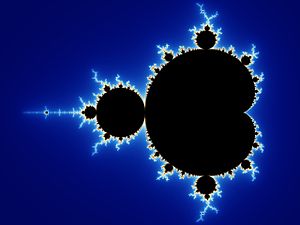

A fractal is generally "a rough or fragmented geometric shape that can be split into parts, each of which is (at least approximately) a reduced-size copy of the whole,"[1] a property called self-similarity. The term was coined by Benoît Mandelbrot in 1975 and was derived from the Latin fractus meaning "broken" or "fractured."
A fractal often has the following features:[2]
- It has a fine structure at arbitrarily small scales.
- It is too irregular to be easily described in traditional Euclidean geometric language.
- It is self-similar (at least approximately or stochastically).
- It has a Hausdorff dimension which is greater than its topological dimension (although this requirement is not met by space-filling curves such as the Hilbert curve).
- It has a simple and recursive definition.
Because they appear similar at all levels of magnification, fractals are often considered to be infinitely complex (in informal terms). Natural objects that approximate fractals to a degree include clouds, mountain ranges, lightning bolts, coastlines, and snow flakes. However, not all self-similar objects are fractals—for example, the real line (a straight Euclidean line) is formally self-similar but fails to have other fractal characteristics.
Images of fractals can be created using fractal generating software.
History

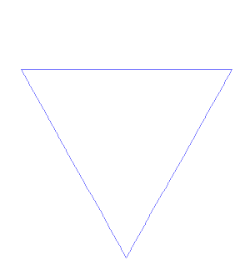
The mathematics behind fractals began to take shape in the 17th century when mathematician and philosopher Leibniz considered recursive self-similarity (although he made the mistake of thinking that only the straight line was self-similar in this sense).
It took until 1872 before a function appeared whose graph would today be considered fractal, when Karl Weierstrass gave an example of a function with the non-intuitive property of being everywhere continuous but nowhere differentiable. In 1904, Helge von Koch, dissatisfied with Weierstrass's very abstract and analytic definition, gave a more geometric definition of a similar function, which is now called the Koch snowflake. In 1915, Waclaw Sierpinski constructed his triangle and, one year later, his carpet. Originally these geometric fractals were described as curves rather than the 2D shapes that they are known as in their modern constructions. The idea of self-similar curves was taken further by Paul Pierre Lévy, who, in his 1938 paper Plane or Space Curves and Surfaces Consisting of Parts Similar to the Whole described a new fractal curve, the Lévy C curve.
Georg Cantor also gave examples of subsets of the real line with unusual properties—these Cantor sets are also now recognized as fractals.
Iterated functions in the complex plane were investigated in the late 19th and early 20th centuries by Henri Poincaré, Felix Klein, Pierre Fatou and Gaston Julia. However, without the aid of modern computer graphics, they lacked the means to visualize the beauty of many of the objects that they had discovered.
In the 1960s, Benoît Mandelbrot started investigating self-similarity in papers such as How Long Is the Coast of Britain? Statistical Self-Similarity and Fractional Dimension, which built on earlier work by Lewis Fry Richardson. Finally, in 1975 Mandelbrot coined the word "fractal" to denote an object whose Hausdorff-Besicovitch dimension is greater than its topological dimension. He illustrated this mathematical definition with striking computer-constructed visualizations. These images captured the popular imagination; many of them were based on recursion, leading to the popular meaning of the term "fractal".
Examples

A relatively simple class of examples is given by the Cantor sets, Sierpinski triangle and carpet, Menger sponge, dragon curve, space-filling curve, and Koch curve. Additional examples of fractals include the Lyapunov fractal and the limit sets of Kleinian groups. Fractals can be deterministic (all the above) or stochastic (that is, non-deterministic). For example, the trajectories of the Brownian motion in the plane have a Hausdorff dimension of 2.
Chaotic dynamical systems are sometimes associated with fractals. Objects in the phase space of a dynamical system can be fractals (see attractor). Objects in the parameter space for a family of systems may be fractal as well. An interesting example is the Mandelbrot set. This set contains whole discs, so it has a Hausdorff dimension equal to its topological dimension of 2—but what is truly surprising is that the boundary of the Mandelbrot set also has a Hausdorff dimension of 2 (while the topological dimension of 1), a result proved by Mitsuhiro Shishikura in 1991. A closely related fractal is the Julia set.
Even simple smooth curves can exhibit the fractal property of self-similarity. For example the power-law curve (also known as a Pareto distribution) produces similar shapes at various magnifications.
Generating fractals
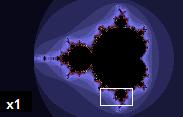
|

|

|
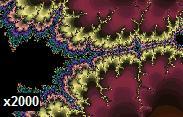 Even 2000 times magnification of the Mandelbrot set uncovers fine detail resembling the full set. Even 2000 times magnification of the Mandelbrot set uncovers fine detail resembling the full set. |
Four common techniques for generating fractals are:
- Escape-time fractals — (also known as "orbits" fractals) These are defined by a recurrence relation at each point in a space (such as the complex plane). Examples of this type are the Mandelbrot set, Julia set, the Burning Ship fractal, the Nova fractal and the Lyapunov fractal. The 2d vector fields that are generated by one or two iterations of escape-time formulae also give rise to a fractal form when points (or pixel data) are passed through this field repeatedly.
- Iterated function systems — These have a fixed geometric replacement rule. Cantor set, Sierpinski carpet, Sierpinski gasket, Peano curve, Koch snowflake, Harter-Heighway dragon curve, T-Square, Menger sponge, are some examples of such fractals.
- Random fractals — Generated by stochastic rather than deterministic processes, for example, trajectories of the Brownian motion, Lévy flight, fractal landscapes and the Brownian tree. The latter yields so-called mass- or dendritic fractals, for example, diffusion-limited aggregation or reaction-limited aggregation clusters.
- Strange attractors — Generated by iteration of a map or the solution of a system of initial-value differential equations that exhibit chaos.
Classification
Fractals can also be classified according to their self-similarity. There are three types of self-similarity found in fractals:
- Exact self-similarity — This is the strongest type of self-similarity; the fractal appears identical at different scales. Fractals defined by iterated function systems often display exact self-similarity.
- Quasi-self-similarity — This is a loose form of self-similarity; the fractal appears approximately (but not exactly) identical at different scales. Quasi-self-similar fractals contain small copies of the entire fractal in distorted and degenerate forms. Fractals defined by recurrence relations are usually quasi-self-similar but not exactly self-similar.
- Statistical self-similarity — This is the weakest type of self-similarity; the fractal has numerical or statistical measures which are preserved across scales. Most reasonable definitions of "fractal" trivially imply some form of statistical self-similarity. (Fractal dimension itself is a numerical measure which is preserved across scales.) Random fractals are examples of fractals which are statistically self-similar, but neither exactly nor quasi-self-similar.
In nature
Approximate fractals are easily found in nature. These objects display self-similar structure over an extended, but finite, scale range. Examples include clouds, snow flakes, crystals, mountain ranges, lightning, river networks, cauliflower or broccoli, and systems of blood vessels and pulmonary vessels. Coastlines may be loosely considered fractal in nature.
Trees and ferns are fractal in nature and can be modeled on a computer by using a recursive algorithm. This recursive nature is obvious in these examples — a branch from a tree or a frond from a fern is a miniature replica of the whole: not identical, but similar in nature.
In 1999, certain self similar fractal shapes were shown to have a property of "frequency invariance" — the same electromagnetic properties no matter what the frequency — from Maxwell's equations (see fractal antenna).[3]
- widths="200px"
-
A fractal that models the surface of a mountain (animation)
-
A fractal fern computed using an Iterated function system
-
Cauliflower fractal
In creative works
Fractal patterns have been found in the paintings of American artist Jackson Pollock. While Pollock's paintings appear to be composed of chaotic dripping and splattering, computer analysis has found fractal patterns in his work.[4]
Decalcomania, a technique used by artists such as Max Ernst, can produce fractal-like patterns.[5] It involves pressing paint between two surfaces and pulling them apart.
Fractals are also prevalent in African art and architecture. Circular houses appear in circles of circles, rectangular houses in rectangles of rectangles, and so on. Such scaling patterns can also be found in African textiles, sculpture, and even cornrow hairstyles.[6]
- widths="200px"
-
A fractal is formed when pulling apart two glue-covered acrylic sheets.
-
High voltage breakdown within a 4″ block of acrylic creates a fractal Lichtenberg figure.
-
Romanesco broccoli showing very fine natural fractals
-
A "woodburn" fractal
-
A magnification of the phoenix set
-
Pascal generated fractal
-
A fractal flame created with the program Apophysis
Applications
As described above, random fractals can be used to describe many highly irregular real-world objects. Other applications of fractals include:[8]
- Classification of histopathology slides in medicine
- Fractal landscape or Coastline complexity
- Enzyme/enzymology (Michaelis-Menten kinetics)
- Generation of new music
- Generation of various art forms
- Signal and image compression
- Creation of digital photographic enlargements
- Seismology
- Fractal in soil mechanics
- Computer and video game design, especially computer graphics for organic environments and as part of procedural generation
- Fractography and fracture mechanics
- Fractal antennas — Small size antennas using fractal shapes
- Small angle scattering theory of fractally rough systems
- Neo-hippies' t-shirts and other fashion
- Generation of patterns for camouflage, such as MARPAT
- Digital sundial
- Technical analysis of price series (see Elliott wave principle)
See also
- Bifurcation theory
- Butterfly effect
- Chaos theory
- Complexity
- Constructal theory
- Contraction mapping theorem
- Diamond-square algorithm
- Droste effect
- Feigenbaum function
- Fractal art
- Fractal compression
- Fractal cosmology
- Fractal flame
- Fractal landscape
- Fractint
- Fracton
- Graftal
- Greeble
- Lacunarity
- List of fractals by Hausdorff dimension
- Publications in fractal geometry
- Newton fractal
- Recursion
- Recursionism
- Sacred geometry
- Self-reference
- Strange loop
- Turbulence
References
- ^ Mandelbrot, B.B. (1982). The Fractal Geometry of Nature. W.H. Freeman and Company. ISBN 0-7167-1186-9.
- ^ Falconer, Kenneth (2003). Fractal Geometry: Mathematical Foundations and Applications. John Wiley & Sons, Ltd. pp. xxv. ISBN 0-470-84862-6.
- ^ Hohlfeld,R., and Cohen, N.,"SELF-SIMILARITY AND THE GEOMETRIC REQUIREMENTS FOR FREQUENCY INDEPENDENCE IN ANTENNAE ", Fractals, Vol. 7, No. 1 (1999) 79-84
- ^ Richard Taylor, Adam P. Micolich and David Jonas. Fractal Expressionism : Can Science Be Used To Further Our Understanding Of Art?
- ^ A Panorama of Fractals and Their Uses by Michael Frame and Benoît B. Mandelbrot
- ^ Ron Eglash. African Fractals: Modern Computing and Indigenous Design. New Brunswick: Rutgers University Press 1999.
- ^ Peng, Gongwen (21 July 1990). "The fractal nature of a fracture surface". Journal of Physics A. 23 (14): 3257–3261. doi:10.1088/0305-4470/23/14/022. Retrieved 2007-06-02.
{{cite journal}}: Unknown parameter|coauthors=ignored (|author=suggested) (help) - ^ "Applications". Retrieved 2007-10-21.
Further reading
- Barnsley, Michael F., and Hawley Rising. Fractals Everywhere. Boston: Academic Press Professional, 1993. ISBN 0-12-079061-0
- Falconer, Kenneth. Techniques in Fractal Geometry. John Willey and Sons, 1997. ISBN 0-471-92287-0
- Jürgens, Hartmut, Heins-Otto Peitgen, and Dietmar Saupe. Chaos and Fractals: New Frontiers of Science. New York: Springer-Verlag, 1992. ISBN 0-387-97903-4
- Benoît B. Mandelbrot The Fractal Geometry of Nature. New York: W. H. Freeman and Co., 1982. ISBN 0-7167-1186-9
- Peitgen, Heinz-Otto, and Dietmar Saupe, eds. The Science of Fractal Images. New York: Springer-Verlag, 1988. ISBN 0-387-96608-0
- Clifford A. Pickover, ed. Chaos and Fractals: A Computer Graphical Journey - A 10 Year Compilation of Advanced Research. Elsevier, 1998. ISBN 0-444-50002-2
- Jesse Jones, Fractals for the Macintosh, Waite Group Press, Corte Madera, CA, 1993. ISBN 1-878739-46-8.
- Hans Lauwerier, Fractals: Endlessly Repeated Geometrical Figures, Translated by Sophia Gill-Hoffstadt, Princeton University Press, Princeton NJ, 1991. ISBN 0-691-08551-X, cloth. ISBN 0-691-02445-6 paperback. "This book has been written for a wide audience..." Includes sample BASIC programs in an appendix.
- Sprott, Julien Clinton (2003). Chaos and Time-Series Analysis. Oxford University Press. ISBN 0-19-850839-5 and ISBN 978-0-19-850839-7.
- Bernt Wahl, Peter Van Roy, Michael Larsen, and Eric Kampman Exploring Fractals on the Macintosh, Addison Wesley, 1995. ISBN 0-201-62630-6
- Nigel Lesmoir-Gordon. "The Colours of Infinity: The Beauty, The Power and the Sense of Fractals." ISBN 1-904555-05-5 (The book comes with a related DVD of the Arthur C. Clarke documentary introduction to the fractal concept and the Mandelbrot set.
- Gouyet, Jean-François. Physics and Fractal Structures (Foreword by B. Mandelbrot); Masson, 1996. ISBN 2-225-85130-1, and New York: Springer-Verlag, 1996. ISBN 0-387-94153-1. Out-of-print. Available in PDF version at [1].
External links
Template:Link FA Template:Link FA Template:Link FA Template:Link FA




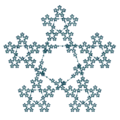

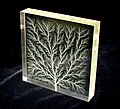
![Fractal branching occurs in a fractured surface such as a microwave-irradiated DVD[7]](http://upload.wikimedia.org/wikipedia/commons/thumb/3/3c/Microwaved-DVD.jpg/120px-Microwaved-DVD.jpg)





